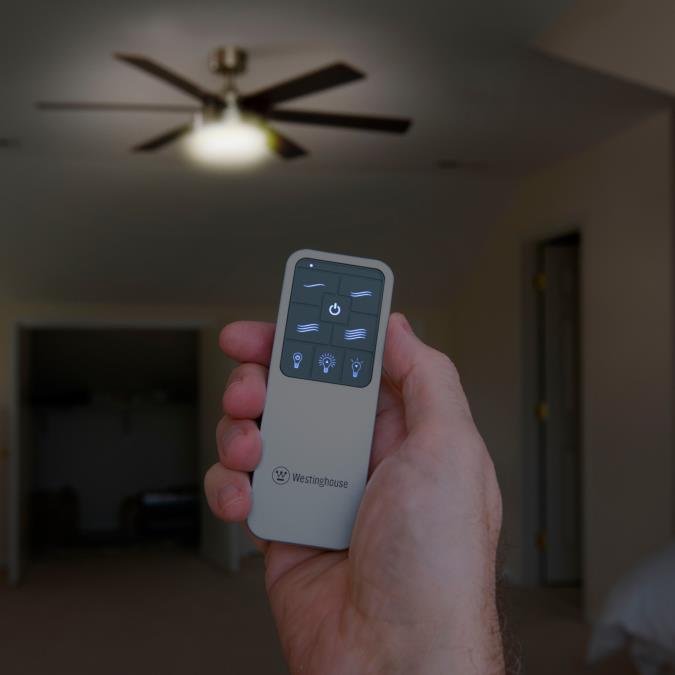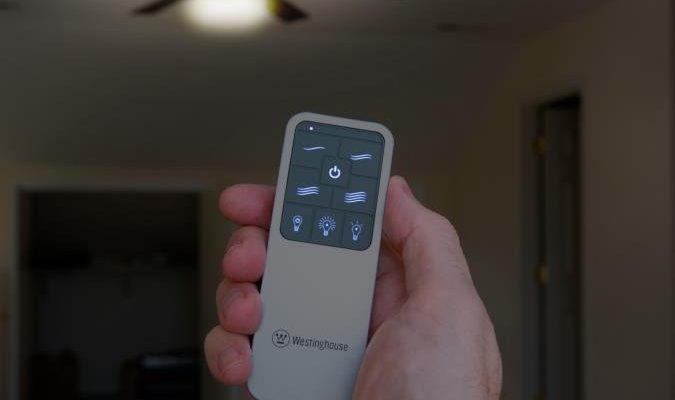
But here’s the thing: ceiling fan remotes aren’t always as “universal” as we’d like. Westinghouse, for example, makes a range of remotes (some with fancy features, others as simple as a single button). Can these remotes cross over and work with different fan brands like Hunter, Hampton Bay, or Harbor Breeze? Or are you stuck in “brand jail”? Let’s untangle the wires and get to the real answer.
How Most Ceiling Fan Remotes Actually Work
You might picture a ceiling fan remote as a tiny magic wand that just points and commands. Honestly, it’s a bit more technical. Most ceiling fan remotes use **RF (radio frequency) signals**, not infrared like your TV remote. This means you don’t have to aim the remote directly at the fan—handy if the fan is way up on a vaulted ceiling.
Here’s where it gets technical: for a remote to work with a fan, both devices must “speak” the same language—meaning the **receiver in your fan** needs to match the signal code sent by your remote. Each Westinghouse remote and receiver pair comes set to a particular radio frequency, often controlled by small DIP switches tucked inside the remote’s battery compartment and the receiver (the part hidden in your fan canopy).
So, picture two walkie-talkies set to different channels—no matter how loud you holler, they just won’t connect. That’s why even a genuine Westinghouse remote might not work with your fan unless the codes match or you can reset and reprogram both pieces.
Are Westinghouse Remotes Universal or Brand-Locked?
You might be hoping for a simple “Yes, any remote works with any fan.” But Westinghouse remotes aren’t built as true universal remotes. They’re mostly designed to pair with **Westinghouse brand receivers**, using their specific signal protocols and codes.
Here’s what usually happens:
- If your other-brand ceiling fan uses an identical or compatible receiver (same frequency, same DIP switch setup), then you *might* be able to sync a Westinghouse remote.
- If your fan brand uses different frequencies, unique codes, or a fancy proprietary system? The remote will likely leave your fan stone-cold silent.
Let me paint a picture: imagine trying to unlock your neighbor’s front door with your house key. Sometimes, in rare cases, the key (remote) and lock (receiver) match up, but it’s never guaranteed. Westinghouse designs most of their remotes for their own models, and other brands (like Hunter, Harbor Breeze, or Hampton Bay) do the same.
Can You Make a Westinghouse Remote Work With Another Brand?
If you’re determined, there are a few technical workarounds, but it’s not for the faint of heart. The first step? **Check if both fans use the same frequency and code system**. Most ceiling fan receivers—yes, even those from different brands—use DIP switches for manual code setting.
Here’s the step-by-step logic:
- Remove the battery cover on the Westinghouse remote—look for a bank of tiny switches (DIP switches). Take note of their position.
- Next, kill the power to your ceiling fan at the breaker (safety first!). Open the fan canopy and find the receiver. Look for a matching set of DIP switches.
- If your non-Westinghouse fan’s receiver has the same number and style of DIP switches, try matching the code from the Westinghouse remote to the fan receiver.
- Turn the power back on. Test the Westinghouse remote to see if the fan responds. Sometimes, it’s as simple as hitting the right “sync” combo.
But—and this is important—if your other-brand fan uses a digital pairing process (no DIP switches, but a “learn” button, for example), or if the receiver and remote use totally different frequencies, you’re out of luck. Westinghouse remotes generally won’t pair.
Tip: If you’re shopping for replacement remotes, always look up your fan’s model number and check both brands’ frequency ranges and code settings.
Common Problems When Mixing Remote and Fan Brands
It sounds easy—just match a few switches and you’re golden, right? Not always. Mixing and matching brands can cause a whole host of **troubleshooting headaches**.
- Signal mismatch: The most common problem is the remote and receiver simply don’t communicate. Different frequencies, protocols, or even the wrong code will give you zero response.
- Partial functionality: Sometimes you’ll get lucky, and the remote will turn the fan on and off, but maybe the light control, speed adjustment, or reverse function doesn’t work. That’s because some features need unique signals or additional wires.
- Resetting issues: In some cases, trying to sync a Westinghouse remote with another brand will reset both your remote and receiver, so you may lose your original settings. Keep this in mind before experimenting.
- Battery life confusion: If your remote “sort of” works or has spotty range, check the batteries first. Weak power can make troubleshooting feel like chasing a ghost.
If you start to notice your Westinghouse ceiling fan remote isn’t controlling all the functions on a different brand’s fan, it’s likely not a defect—it’s a compatibility issue.
How to Identify Your Fan’s Receiver Type Before Pairing
Before you even think about pairing, it’s worth figuring out exactly what kind of receiver your non-Westinghouse fan uses. This step saves a lot of heartache—and unnecessary purchases.
Manual inspection is your friend: Shut off power, lower the fan’s canopy, and check for:
- DIP switches: Looks like a row of little toggles or slide switches. These are the most “cross-compatible” with remotes—if the brand and frequency match.
- Digital/learn button: Modern fans may have a “learning mode” button that syncs with a remote by holding it down during pairing. Most Westinghouse remotes don’t support this type of pairing if not designed for it.
- No receiver inside: Surprisingly, some older or very basic fans don’t have a receiver at all—they’re hardwired to a wall control. In this case, a remote (any remote) simply won’t work until you add a universal remote receiver kit.
It pays off to check the manual. Many brands use very clear stickers on the receiver or inside the fan canopy listing frequencies and code types. If you see a table of codes or a “learn” button, you’ll know what you’re working with.
Universal Ceiling Fan Remotes Versus Brand-Specific Remotes
Let me explain why “universal” remotes exist and where they fit into this puzzle. Universal ceiling fan remotes are meant to work with a wide range of receiver types and brands. They often come with multiple code settings—sometimes hundreds—to maximize compatibility. However, even these have limits.
- Universal remote kits usually include both a new receiver (to install in your fan) and a new remote. That way, you’re guaranteed both parts speak the same language.
- If you only swap the remote and not the receiver, you’re gambling on code compatibility. In most cases, a universal remote won’t talk to a proprietary, brand-locked receiver.
- Westinghouse remotes, while reliable, fall into the “brand-specific” pile more often than not. They’re reliable for Westinghouse fans but not truly “plug and play” for other brands.
If you’re hoping for a single remote to control multiple fan brands throughout your home, a universal kit is your best bet. Otherwise, stick with the manufacturer’s recommendations.
What About Smart Home and WiFi Ceiling Fan Controls?
These days, plenty of fans offer smart control features that use WiFi, Bluetooth, or a smart hub instead of old-school RF signals. If your other-brand fan uses smart remote technology, a standard Westinghouse ceiling fan remote won’t communicate with it at all.
Think of smart remotes as a whole different animal. Instead of using DIP switches or radio frequencies, they might use app-based code, cloud pairing, or even voice commands via Alexa or Google Home. You can’t cross the streams here—traditional RF remotes and smart remotes don’t talk to each other.
Honest opinion? This is where a lot of DIY-ers get stuck. They buy a “regular” remote, only to find out their fan is another kind of smart. Always check your fan’s manual or support site before buying a replacement.
When Should You Replace the Receiver Instead?
Let’s say your Westinghouse remote is lost, broken, or you desperately want all your fans to work on the same control. Sometimes, the fix isn’t the remote—but the receiver.
If your fan can physically fit a universal receiver inside the canopy, swapping out the receiver lets you use almost any universal ceiling fan remote going forward. Here’s how the process works:
- Purchase a universal receiver/remote kit (they’re sold together).
- Shut off power, lower the fan canopy, and carefully swap the old receiver for the new one (follow the included wiring diagram—seriously, don’t improvise).
- Set your new remote and receiver codes to match, power everything up, and pair as instructed.
This upgrade is especially helpful if you’re mixing different brands and want to standardize control throughout your home. Just double-check your fan has enough space for the new receiver—some compact models are really tight inside.
Final Thoughts: Mixing Westinghouse Ceiling Fan Remotes With Other Brands
Here’s the honest takeaway: while it’s tempting to grab a spare Westinghouse remote and try to sync up with another brand’s fan, it rarely works unless both use the same code system and frequency. Most Westinghouse remotes are made for Westinghouse receivers. Occasionally, you’ll get lucky if the code settings line up, but don’t count on it. Swapping in a universal receiver and matching remote is usually the smoother fix, especially if you’re ready to ditch the brand silo.
Before you buy or start poking around wires, take a minute to check the receiver type inside your fan and consult your model’s manual. If all this sounds complex, you’re not alone—ceiling fan remotes are way more fussy than most folks expect. But with a bit of patience, a screwdriver, and the right info, you can keep every breeze under your control.
